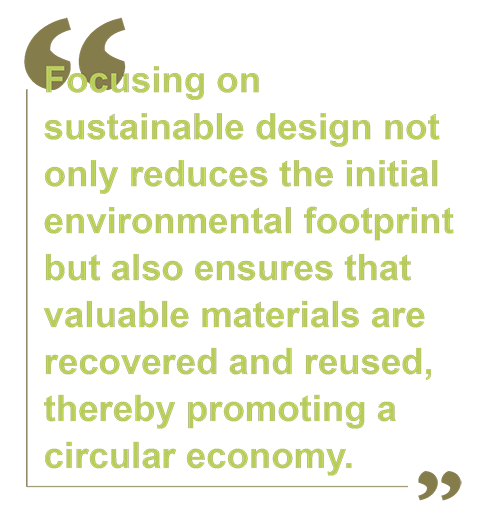THE ROLE OF ADDITIVE MANUFACTURING FOR A GREENER FUTURE
An interview with Davoud Jafari
In an era where sustainability is crucial, additive manufacturing (AM) stands out as a significant technology for innovation and environmental responsibility. By minimizing waste, enabling lightweight design, and addressing supply chain challenges, AM not only aligns with the principles of the circular economy but also meets the pressing need for eco-friendly production methods.
However, realizing its full potential requires overcoming significant challenges. Davoud Jafari, an assistant professor at the University of Twente, talks to the Fraunhofer Innovation Platform for Advanced Manufacturing about how additive manufacturing offers a transformative approach to sustainable manufacturing, the obstacles it faces, and the strategic steps needed to ensure it contributes effectively to a sustainable future.

Tell us about Additive Manufacturing (AM) and how it contributes to sustainable manufacturing practices.
AM, also known as 3D printing, presents a compelling opportunity for a more sustainable production paradigm aligned with circular manufacturing principles. However, its impact on achieving net zero production is a complex issue with both advantages and shortcomings. In particular, AM offers several advantages that contribute to sustainable practices and align with circular economy principles. One major benefit is the reduction of material waste. Unlike traditional manufacturing methods that generate substantial scrap, AM builds objects layer-by-layer, thereby minimizing material waste. This efficiency directly contributes to closing the material loop in a circular economy by maximizing resource utilization.
Another advantage of AM is its potential for lightweight design. AM excels at creating complex, lightweight structures, enabling the production of lighter airplanes, cars, and other products. The reduced weight of these products translates to lower energy consumption throughout their operational lifespan. This approach not only enhances energy efficiency but also supports the principles of design for lifespan and disassembly, which are integral components of circular manufacturing. Additionally, AM enhances manufacturing flexibility. It is particularly adept at producing small batches and customized products, reducing the need for large production runs. This capability can lower transportation requirements, thereby minimizing the environmental footprint associated with logistics. The flexibility of AM fosters ondemand and localized manufacturing, which are also key aspects of circular economies. By enabling more efficient resource use, reducing waste, and supporting sustainable product lifecycle management, AM plays a crucial role in advancing sustainable manufacturing practices.
Looking ahead, what challenges currently hinder AM’s ability to contribute to a more sustainable future? What recommendations can you provide to ensure AM fulfills its potential for environmental responsibility?
AM holds promise for a more sustainable future. However, to fully unlock this potential, we need to think about the entire AM lifecycle, minimizing waste and maximizing resource recovery. Several strategies can be implemented:

Energy consumption concerns:
The AM process itself can be energyintensive, particularly for certain technologies. In some cases, the energy savings from reduced material waste might be negated by the printing process itself. Optimizing printing processes and utilizing alternative energy sources are important to address this challenge. This involves fine-tuning print parameters and designing support structures that minimize material usage. Additionally, any unavoidable printing waste should be collected and reused in new prints, further reducing the overall environmental footprint.

Limited environmental data :
Current data on the environmental impact of various AM materials and processes is often lacking. This makes it difficult to make fully informed decisions that prioritize sustainability. Life cycle assessments (LCAs) that consider the entire production chain, including pre-processing, post-processing, and machine utilization, are essential for understanding AM’s environmental footprint.

Focus beyond single parts – LCA for transparency :
LCAs of AM often overlook critical stages, focusing primarily on the printed part itself. This typically neglects the environmental impact of pre-processing (such as powder preparation), post-processing (like support removal and finishing), and the energy consumption of utilized machines. To compare AM with traditional manufacturing methods, it is essential to expand the scope of LCAs to include the entire AM lifecycle. This provides fair comparisons with traditional manufacturing and identifies areas for improvement.

Reducing emissions with on-demand AM: :
Gone are the days of lengthy supply chains and the associated carbon footprint of transportation. AM empowers local, on-demand manufacturing, enabling production closer to consumers. This not only streamlines logistics but also significantly reduces greenhouse gas emissions associated with longdistance shipping. By decentralizing production, companies can respond more quickly to market demands and reduce the environmental impact of moving goods across the globe.
Sustainable design principles:
Sustainable design is a powerful concept that shapes modern manufacturing. It ensures products are built with both efficiency and the environment in mind. Designers use specialized tools to assess a product’s entire life cycle, from creation to disposal. This approach incorporates key strategies:
![]()
Minimize material usage – careful material selection ensures products are built with only what’s necessary, reducing waste and resource consumption.
![]()
Prioritize energy efficiency – designing for energy-efficient operation throughout a product’s life minimizes its overall environmental impact.
![]()
Design for disassembly – easy disassembly at the end of a product’s life allows valuable materials to be recovered and recycled for future use. This philosophy extends beyond simple “use and discard.” By embracing concepts like “design for repair” and “design for remanufacturing,” products become easier to disassemble, update, or rebuild. This extends their lifespan, reduces reliance on virgin materials, and minimizes waste generation altogether.
In essence, sustainable design creates a win-win scenario for both manufacturers and the environment.

Closing the loop with recycled materials:
Imagine a world where waste from AM processes no longer exists. Advancements in recycling and upcycling technologies allow leftover 3D printing materials to be transformed back into high-quality feedstock for new products. This reduces dependence on virgin materials, lessens environmental impact, and conserves natural resources. Prioritizing bio-based or recycled materials further diminishes the environmental footprint compared to using raw materials. Additionally, incorporating recycled content from other industries into the 3D printing process creates a closed-loop system, turning waste into valuable resources and keeping it out of landfills.

This closed-loop system is more than a recycling strategy; it represents a shift in our approach to production and waste. By continually recycling and reusing materials in AM, we establish a sustainable cycle that meets industry needs and environmental goals. This visionary approach promises a future where waste is nearly eliminated, leading to more sustainable and eco-friendly manufacturing practices.
Tell us about your scientific research interest and its link to AM for a Greener Future.
We develop and investigate the fundamental science and engineering of energy materials through AM. We aim to tailor and control functions related to thermodynamics, kinetics, and transport, including providing surfaces for thermochemical or electrochemical reactions, conducting electrons and heat, and distributing fluids. My research team, the AM Solutions for Energy Materials, focuses on enhancing AM processes to create and test complex geometrical shapes and realize hierarchical structures with graded composition and length scales ranging from micrometers to centimeters. We are currently focused on three application areas: (1) heat transfer, (2) electrochemical systems, and (3) thermochemical systems. A key challenge in our research is obtaining control over properties to tailor them for sustainable energy solutions.

The recycling of energy materials such as porous electrodes that are used in batteries, fuel cells, and supercapacitors aligns perfectly with the growing movement towards a greener future. With AM, the design possibilities are virtually limitless. Engineers can design energy solutions such as batteries with built-in features that facilitate easier disassembly and material separation at the end of their lifespan.
This directly addresses the challenges of recycling complex structures. By combining efficient recycling methods for existing materials with the innovative design and production capabilities of AM, we can achieve a future with sustainable energy solutions. This not only ensures responsible handling of valuable resources but also paves the way for cleaner and more efficient energy use.
As we wrap up our discussion, could you share your final insight?
By addressing its current shortcomings and leveraging its strengths, AM has the potential to be a transformative technology for achieving net zero production. Focusing on sustainable design not only reduces the initial environmental footprint but also ensures that valuable materials are recovered and reused, thereby promoting a circular economy. By integrating the above principles, designers can create products that are efficient, environmentally friendly, and sustainable from conception to end-of-life. This benefits the planet and creates a more resilient and resource-efficient manufacturing landscape.
